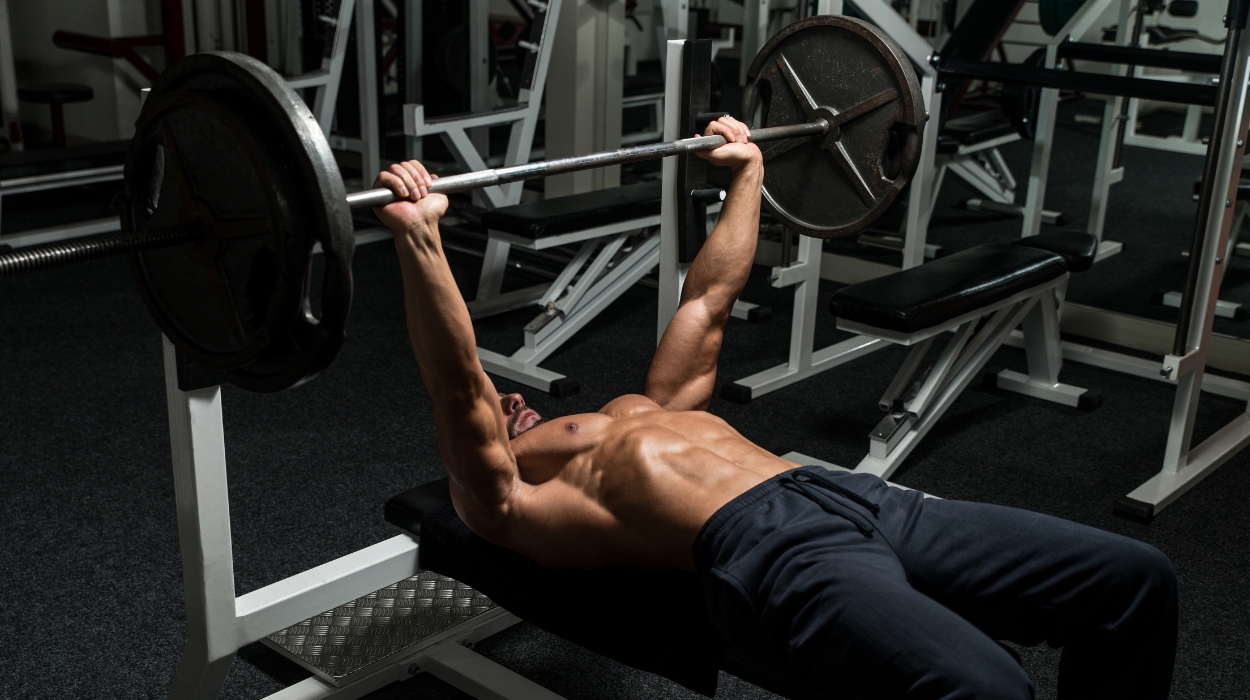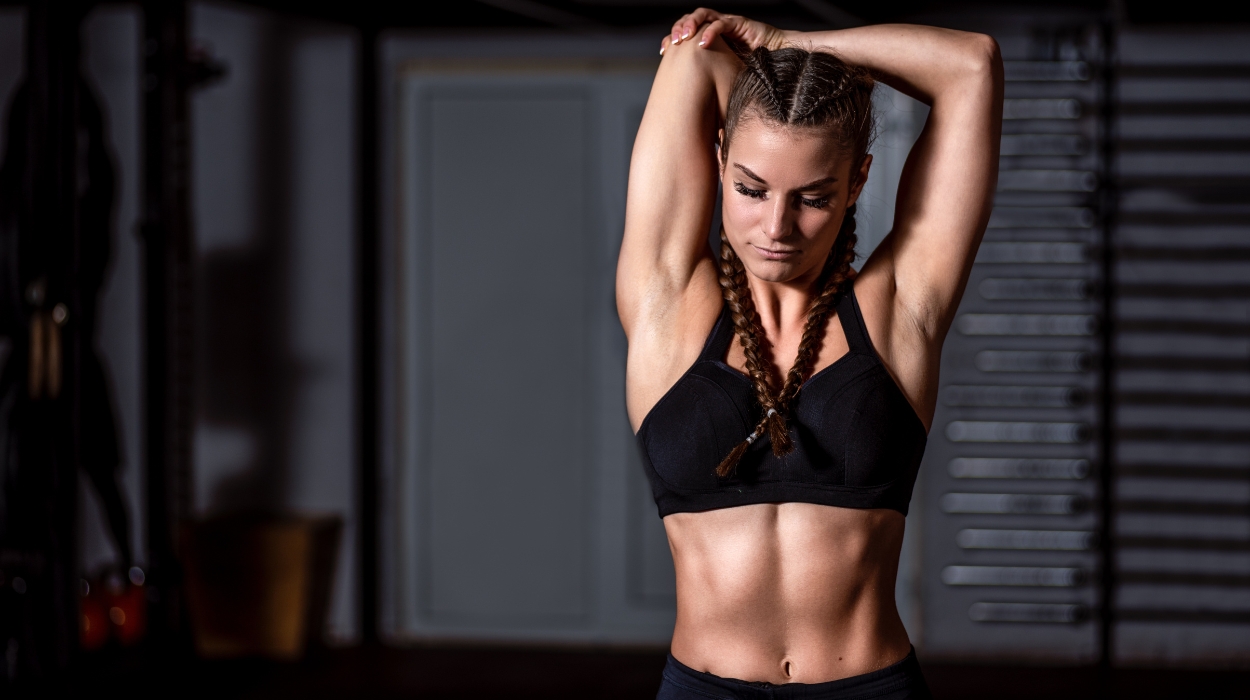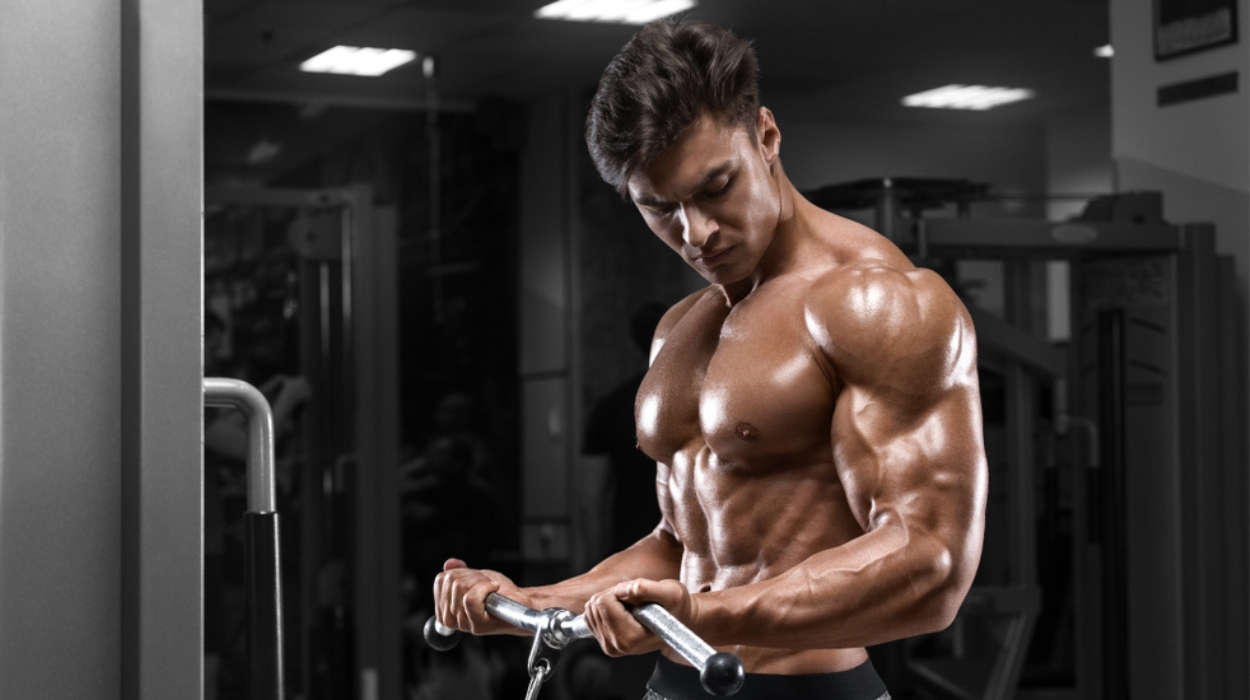There’s more to getting a ripped physique and six-pack abs than just lifting weights. It takes a whole routine to achieve your dream body.[1] You can learn how to get shredded fast and boost muscle growth.
Here, you can find ways to get a shredded body and eliminate excess fat. Weight training is integral to the equation, mixed with what you eat.
Stick to healthy foods, and add fat-burning supplements to your diet. In addition, eat a calorie deficit and get ample sleep to enhance muscle growth. Getting a ripped body takes time and dedication, so be ready for a six to twelve-month commitment.
How To Get Shredded Fast
- Start weight training.
- Add high-intensity interval training.
- Stop eating processed foods.
- Focus on a healthy diet.
- Eat a calorie deficit.
- Take fat-burning supplements.
- Increase daily protein intake.
- Get enough sleep.
8 Ways To Get A Shredded Body

Many people want to know how to get shredded and lose body fat fast. Building lean muscle mass and losing fat takes time and requires commitment. Still, it’s not an impossible goal to get a great body once you learn how to become shredded.
Here are 8 ways to get a shredded body and reduce fat stores today:
Start Weight Training
Getting a shredded body requires a commitment to weight training.[2] You can hit the gym or workout at home to build lean mass.
Essentially, weight training is contracting your muscles against resistance.[3] It’s also called strength or resistance training and involves lifting weights. Weight training is one of the best ways to get a shredded body, boost weight loss, and get lean body mass.
There are many health benefits that you enjoy when weight training. It helps to increase fat burning[4] as you build muscle for that ripped physique. Resistance training can decrease body fat by 1.46%[5] and is an effective way to eliminate belly fat.
Resistance training, as you age, is a good addition to a workout routine since it reduces the risk of falling.[6]
Add High-Intensity Interval Training
Getting a shredded body starts with burning fat to get rid of it. Resistance training is great for building muscles. However, burning fat also requires doing more cardio at home or in the gym.
High-intensity interval training can help you burn more calories[6] quickly to achieve weight loss goals. Exercising to burn fat goes hand in hand with weight training to build muscle and get ripped.
During a high-intensity interval training session, keep your heart rate elevated to burn body fat. A good high-intensity interval training session[7] can come after lifting weights. Maintaining a pace that works to get a lean body is a winning formula. HIIT involves bursts of energy followed by brief rest periods.
Stop Eating Processed Foods
Achieving shredded muscles requires many changes, especially in diet. It’s time to clean up your plate and stop eating processed foods.
Today, supermarkets and grocery stores are packed with highly processed foods.[8] However, if you want a shredded body, it’s better to eliminate them from your diet. Instead, focus on healthy eating to lose weight faster.
Processed foods have undergone alteration during the preparation stage, adversely affecting the final product.[9] It’s worth noting that not all are terrible for human consumption. However, removing the nutritious parts makes most processed foods unhealthy, making many of them high in sodium, fat, or sugar.
Examples of processed foods include white rice,[10] white bread, and white pasta. Instead, choose brown rice, whole wheat bread, and whole grain pasta.[11] Such food options have loads of vitamins, antioxidants,[12] and minerals beneficial for your health.
Eating healthy improves your health and well-being. You have more energy for lifting weights and high-intensity interval training.
Focus On A Healthy Diet
Besides hitting the gym to do resistance training, consider what you eat to get shredded. Food is key to a healthy body and good physique. A healthy diet[13] is essential and must be part of your routine.
It’s better to devise a meal plan and cook food at home. That gives you more control over the ingredients and what you consume daily. A good diet includes complex carbs,[14] lean meats or other protein sources, healthy fats,[15] vegetables, and fruits.
A good example of complex carbs to add to your diet is sweet potato. Also, have fruit, and top up with leafy green vegetables[16] to boost your health.
Eat A Calorie Deficit
Too many calories lead to weight gain[17] and lots of fat in the body. That’s why it’s good to consider eating fewer calories to lose weight. A calorie deficit helps you burn fat while working on proper muscle growth.
Once you eat a calorie deficit[18] to get shredded, take stock of your activities, and keep in mind the duration you work out or are active each day. The goal is to base the calorie intake on your level of activity.
One caution is always consuming enough calories to support muscle growth[19] and development. Eating too little food to cut calories can hamper your efforts to get ripped. You might need more calories to build muscle mass if you already have less body fat.
Take Fat Burning Supplements
How much fat do you need to lose as you work on getting ripped? Knowing the right body fat percentage to achieve is a great place to start to get shredded.
Fat-burning supplements[20] are a great addition when you want to lose weight. Fat burners are pills that contain artificial or natural ingredients that help you get lean. They increase your resting metabolic rate,[21] so you burn more fat even when relaxing.
However, it’s worth noting that fat-burning supplements aren’t magic pills. It’s good to remain active by running, swimming, exercising,[22] and eating healthy foods.
Increase Daily Protein Intake
Add more lean protein to your daily food consumption to boost muscle growth. Protein is an essential building block for different muscle groups in your body. Therefore, increasing protein intake can help you build and maintain lean muscle mass.
Adding 1.2 to 1.5 grams/kilogram of protein[23] is a great place to boost muscle growth. Elite athletes[24] can work with 2.0 g/kg to lose weight and get a ripped physique. Ensure at least 30% of your daily calories is protein.
Examples of good protein choices include:
- Lean meats.[25]
- Eggs.
- Tofu.[26]
- Salmon.
- Lentils.
- Quinoa.
Get Enough Sleep
Sleep is an integral part of your health and wellness. In fact, you must get enough sleep if you want to gain muscle.[27] Work on getting eight to nine hours of uninterrupted sleep each day to get ripped.
Weight training and cardio can take a toll on your body. Recovery time[28] is handy since you can soothe soreness and improve mental health. Recovery time for men is 48 hours, and for women is 4 hours.
Intense weight training mixed with cardio will leave you feeling tired. Using all that energy can drain you, so sleep helps your body recover. In addition, you have time for muscle recovery and muscle growth.
Sleeping at least eight hours a day is better to avoid sleep deprivation[29] to prevent muscle catabolism. Otherwise, sleeping fewer hours can hinder muscle recovery. Lack of sleep also leads to poor cognition[30] and productivity.
Lastly, getting enough sleep after a day of resistance training to get shredded can reduce physical fatigue. At the same time, you can enjoy more mental alertness during the day.
What Is A Shredded Physique?
Achieving a shredded physique occurs when you reduce body fat percentage and gain muscle. Frankly, your entire body composition changes as you lift weights and change your diet. The whole process of shredding is to become lean and improve your body shape.
A shredded physique is attractive and a goal for many people. It requires lots of commitment and life adjustments to reach the set goal. In this article are eight ways to get shredded and look your best.
Benefits Of Getting Shredded

Transforming your body composition requires time and dedication. However, there are benefits of getting shredded that can inspire you. These include:
Better Heart Health
Getting ripped requires getting rid of excess body fat and boosting muscle growth. Lowering body fat percentage is integral for heart health.[31] That’s because having lots of subcutaneous fat can lead to issues such as heart disease[32] and high blood pressure.
Hitting the gym to lift weights and do cardio helps you burn fat and become leaner. As a result, you promote good heart health by improving its ability to pump blood.
Looking Good
Honestly, a ripped body looks amazing and can attract lots of attention. Getting shredded helps improve your body composition and can even improve your self-esteem. Looking good keeps you in a great mood, and you can be more productive.
Reasons Why You Can’t Get Shredded
Getting shredded muscles and being in the best shape of your life is possible. Above is a list of different ways to build lean muscle mass. However, if you are putting in all the effort to master how to get ripped and seeing no results, here’s why:
Low Testosterone
Testosterone plays an integral part in building muscle and getting ripped. So, if you have a hard time getting shredded, that might be a sign of low testosterone.[33] The hormone plays an integral part in increasing muscle mass.
Increasing testosterone[34] not only helps you get ripped but also helps you lose weight. You also have more energy crucial when lifting weights.
Some causes of low testosterone in men include fatigue, stress, medication, and excess body fat.[35] Narrowing down the cause of low testosterone puts you one step closer to gaining muscle.
Chronic Stress
Taking stock of your emotional health is important when you want a shredded physique. Chronic stress[36] makes it hard to accomplish fitness or body weight goals.
Changing body composition requires motivation and dedication. However, if there’s little or no change, consider how you’re managing stress. High-stress levels can cause you to eat more,[37] leading to weight gain, among other issues.
Rest and self-soothing are integral in your fitness journey to get shredded faster. Therefore, find ways to manage stress, such as deep breathing. Coping better with stressors can get you back on track to getting ripped.
Medication
Consider the type of medication[38] you’re taking as you work to burn calories and get shredded. Antidepressants, for example, are linked to weight gain. If that’s the case, see a healthcare provider to change the medication before you work on getting shredded.
Hidden Calories
It’s essential to watch what you eat to enjoy a shredded physique. Clean eating works best when you want to stop eating processed foods. In addition, you can switch to healthy drinks that boost weight loss.
However, it’s possible to consume hidden calories[39] as you work toward losing fat. For example, a salad is a healthy option to reduce body fat. However, adding a high-calorie dressing or toppings makes the meal unhealthy.
Poor Stretching
A post-workout stretch is crucial to build lean muscle mass. Take time to stretch your entire body, as this helps relieve aches and soreness. In addition, a post-workout stretch[40] is crucial for a better range of motion.
When lifting weights, range of motion[41] helps you stay flexible so you can push yourself. Your body’s connective tissue and joints are healthy and have less chance of injury.
Steady State Cardio
High-intensity interval training is great for fat burning, so you lose fat without losing muscle. However, too much steady-state cardio can hinder getting ripped. Steady-state cardio[42] can work against your body, causing muscle hypertrophy, primarily if you’ve achieved body fat percentage goals.
Conclusion
It’s possible to get shredded and look your best. However, you must be ready to commit to a good routine to achieve a shredded physique. Start weight training to encourage muscle growth and add high-intensity interval training.
Also, embrace healthy eating and stop eating processed foods. Eating a calorie deficit and taking fat-burning supplements can help burn fat for a leaner look. Rest, drink water, and eat the right food to master how to get shredded abs today.
Frequently Asked Questions
A good diet plan and workout routine can help you get ripped faster. Stick to whole foods, add strength training, and do cardio. In addition, take fat-burning supplements and stop eating processed foods to burn fat faster.
Enjoying a shredded physique can take six to twelve months. In that time, create a good plan that helps you burn fat and build muscles in your entire body.
If you want to look good, knowing what to eat is important to get shredded abs. The best meal plan comprises complex carbs, protein, vegetables, healthy fats, and fruits.
Avoid eating processed foods if you want to get shredded. In addition, stick to healthy fats and avoid junk food full of grease and added sugar.
It’s good to pace yourself as you exercise to get a ripped body. If you train daily, do so for less than two hours and have ample time to rest. Do 60 minutes of weight training and 30 minutes of cardio exercise.
 Evidence Based
Evidence Based
